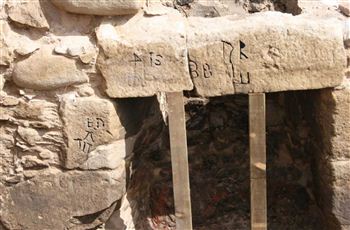By Niamh Anderson

WITCHCRAFT experts are investigating a Halloween mystery unearthed in the far north of Scotland.
Mysterious symbols found inside a building buried under sand for 500 years are believed to been carved by terrified inhabitants to ward off evil spirits.
If confirmed, they would be among the earliest examples of anti-witchcraft symbols ever found in Scotland.
The exciting discovery was made as archaeologists uncovered a long-lost 16th century salthouse on a beach near the tiny village of Brora, Sutherland.
The site is just 16 miles from where the last witch to be burned at the stake in Scotland met her ghastly fate.
The discovery of the building – one of the oldest ever found in Scotland– delighted the researchers.
But the sandstone fireplace yielded an even more remarkable discovery.
Witchcraft
It is covered with intricately-carved crosses, lines and signatures which will now be the subject of a four-month investigation by experts.
The project was led by Historic Scotland, the Clyne Heritage Society, Scottish Coastal Archaeology and the Problem of Erosion (SCAPE) project.
Director of SCAPE, Tom Dawson, said: “The marks found on this fireplace were most definitely designed to keep evil away.”
Mr Dawson said James VI did much to spread fear of witches among the populace.
“He believed he was the son of God and that nothing would ever harm him. When he was sailing back from one of his voyages in Denmark, a storm hit and he refused to believe that it was Gods doing so he blamed it on witches.
“Once the story got around, witchcraft suddenly became very popular in Scotland.
“Everyone was convinced that witches existed and people were frightened so they started carving their fireplaces to warn off any evil from entering their homes.”
Jacqueline Aitkin, a Clyne Heritage Society Archivist, said the superstitious salt workers were trying to protect their expensive commodity.
“It may have been that the wealth of the salt was the reason behind these carvings. The workers would have believed that they needed to protect it and so they decided to carve these symbols in the fireplace to warn off evil.”
Miss Aitkin added that it is no coincidence that the last witch of Scotland was burned in Dornach, close to where the fireplace was found.
A commemorative stone can be found in the town, where Janet Horne died in 1727.
Magic
“The burning of this witch happened only 16 miles away from where the fireplace was found. If this isn’t proof that the people of Brora and Dornach believed in witches existed, then I don’t know what is,” she said.
Dr. Julian Goodare, reader in Scottish History at the University of Edinburgh and author of “Witchcraft and Belief in Early Modern Scotland”, agreed the symbols looked as if they were created to protect the building.
He said: “I would call these symbols protective magic, or counter charms.
“Magical symbols like these were used to protect against evil magic, much like the horse shoe acts as a protective charm for modern day houses even to this day.
“The symbols would have been an insurance against evil during those times.”
During the years 1563 and 1736, over 305 “witches” were executed in Scotland because they weren’t accepted by the church.
Fearful Scots believed that witches had the power to influence the mind, body or possessions. They also blamed witchcraft for disease, sickness in animals, bad luck, sudden death, impotence and other such misfortunes.
The house itself dates back to 1598 and was built by Lady Jane Gordon.
According to Mr Dawson, the house could be one of the oldest buildings in Scotland.
“Houses in Brora tended to be made from turf, but this is made from huge stone blocks, which is very unusual for back then.”
The building, according to Mr. Dawson, was preserved by the three metres of compacted sand that filled in over time, eventually leading to a sand dune.
“The reason why it survived is thanks to the sand dunes. The sand compacted into the building and it reinforced it which kept it standing for all of these centuries,” he added.


